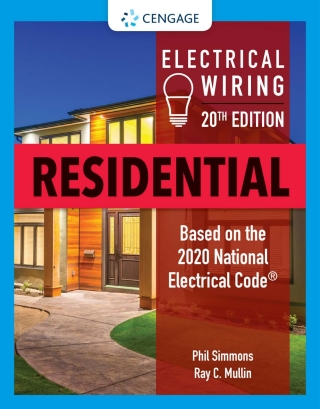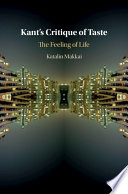Buy Electrical Wiring Residential, 20th Edition PDF ebook by author Ray C. Mullin; Phil Simmons – published by Cengage Learning in 2021 and save up to 80% compared to the print version of this textbook. With PDF version of this textbook, not only save you money, you can also highlight, add text, underline add post-it notes, bookmarks to pages, instantly search for the major terms or chapter titles, etc.
You can search our site for other versions of the Electrical Wiring Residential, 20th Edition PDF ebook. You can also search for others PDF ebooks from publisher Cengage Learning, as well as from your favorite authors. We have thousands of online textbooks and course materials (mostly in PDF) that you can download immediately after purchase.
Note: e-textBooks do not come with access codes, CDs/DVDs, workbooks, and other supplemental items.
eBook Details:
Full title: Electrical Wiring Residential, 20th Edition
Edition: 20th
Copyright year: 2021
Publisher: Cengage Learning
Author: Ray C. Mullin; Phil Simmons
ISBN: 9780357425794, 9780357425770
Format: PDF
Description of Electrical Wiring Residential, 20th Edition:
Featuring the latest industry standards and procedures, longtime market leader ELECTRICAL WIRING RESIDENTIAL, Twentieth Edition, provides comprehensive, authoritative coverage of the 2020 National Electrical Code (NEC), as well as a thorough grounding in essential electrical theory and applications. Drawing on decades of industry and classroom experience, the authors guide students step-by-step through the critical tasks and responsibilities required of today’s professional electricians in both new construction and existing homes. Extremely reader-friendly, the text offers detailed explanations without being overly technical, and content clearly relates the NEC to real-world installation processes. Vivid Illustrations coordinate with the latest NEC regulations to provide further clarity, and foldout plans at the back of the text give students hands-on practice applying code requirements.Important Notice: Media content referenced within the product description or the product text may not be available in the ebook version.
Table of Contents of Electrical Wiring Residential, 20th Edition PDF ebook:
ContentsForewordPrefaceAcknowledgmentsChapter 1: General Information for Electrical InstallationsObjectivesSafety in the WorkplacePersonal Protective EquipmentArc FlashSafety Cannot Be Compromised!TrainingLicensing and PermitsNational Electrical Code (NEC)Language ConventionsBuilding CodesMetrics (SI) and the NECListed Equipment and Nationally Recognized Testing Laboratories (NRTL)ReviewSafety-Related ProblemsChapter 2: Specifications, Electrical Symbols, and OutletsObjectivesPlans and SpecificationsSpecificationsElectrical SymbolsNotationsLuminaires and OutletsOutlet, Device, and Junction BoxesNumber of Conductors in BoxSelecting the Correct Size BoxBox MountingNonmetallic Outlet and Device BoxesGanged Switch (Device) BoxesBoxes for Conduit WiringYokeSpecial-Purpose OutletsHeight of Receptacle OutletsPositioning of ReceptaclesReviewPart 1-Electrical FeaturesPart 2-Structural FeaturesChapter 3: Determining the Required Number of Branch Circuits, Lighting Outlets, and Receptacle OutlObjectivesIntroductionVoltageCalculating LoadsCalculating Floor AreaDetermining the Minimum Number of Lighting Branch CircuitsTrack Lighting LoadsSummary of Where Receptacle and Lighting Outlets Must Be Installed in ResidencesReviewChapter 4: Conductor Sizes and Types, Wiring Methods, Wire Connections, Voltage Drop, and Neutral CoObjectivesConductorsPermissible Loads on Branch Circuits (210.23)Aluminum ConductorsConductor InsulationWet, Damp, Dry, and Sunlight LocationsVoltage DropNonmetallic-Sheathed Cable (NEC Article 334)Armored Cable (Type AC) and Metal-Clad Cable (Type MC)Installing Cables through Wood and Metal Framing Members (300.4)Cables in Shallow Grooves and ChasesInstallation of Cables through DuctsConnectors for Installing Nonmetallic-Sheathed and Armored CableIntermediate Metal Conduit (Article 342), Rigid Metal Conduit (Article 344), Rigid PVC Conduit (ArtiFlexible ConnectionsElectrical Nonmetallic Tubing (ENT) (Article 362)Service-Entrance Cable (Article 338)ReviewChapter 5: Conductor Identification, Switch Control of Lighting Circuits, Bonding/Grounding of WirinObjectivesConductor Identification [NEC Articles 200 and 210]Connecting Wiring DevicesPush-In TerminationsToggle Switches (Article 404)Combination Wiring DevicesTimersReviewChapter 6: Ground-Fault Circuit Interrupters, Arc-Fault Circuit Interrupters, Surge Protective DevicObjectivesElectrical Shock HazardsNEC Requirements for Ground-Fault Circuit Interrupters (210.8)Feed-Through Ground-Fault Circuit InterrupterTesting and Recording of Test Data for GFCI ReceptaclesArc-Fault Circuit Interrupters (AFCIs)Other Special-Purpose ReceptaclesReplacing Existing ReceptaclesPersonnel Ground-Fault Protection for All Temporary WiringImmersion Detection Circuit Interrupters (IDCIs) and Appliance Leakage Current Interrupters (ALCIs)Surge Protective Devices (SPDs)ReviewChapter 7: Luminaires, Ballasts, and LampsObjectivesWhat Is a Luminaire?Types of LuminairesFluorescent Ballasts and Lamps, Incandescent Lamps, and LEDsLamp EfficacyLamp Color TemperatureReviewChapter 8: Lighting Branch Circuit for the Front BedroomObjectivesIntroductionResidential LightingLaying Out General-Purpose Lighting and Receptacle CircuitsEstimating Loads for OutletsSymbolsDrawing a Cable Layout and Wiring DiagramDrawing the Wiring Diagram of a Lighting CircuitLighting Branch Circuit A16 for the Front BedroomDetermining the Size of Outlet Boxes, Device Boxes, Junction Boxes, and Conduit BodiesGrounding of Wall BoxesPositioning of Split-Wired ReceptaclesPositioning of Receptacles Near Electric Baseboard HeatingLuminaires in Clothes ClosetsReviewChapter 9: Lighting Branch Circuit for the Master BedroomObjectivesIntroductionLighting Branch Circuit A19 for the Master BedroomSliding Glass Doors and Fixed Glass PanelsSelection of BoxesCeiling-Suspended (Paddle) FansReviewChapter 10: Lighting Branch Circuit-Bathrooms, HallwayObjectivesIntroductionLighting Branch Circuit A14 for the Hallway and BathroomsHanging Luminaires in BathroomsHallway LightingReceptacle Outlets in HallwaysEquipment GroundingReviewChapter 11: Lighting Branch Circuit-Front Entry, Porch, Post Light, Underground WiringObjectivesIntroductionCircuit A15Doorjamb SwitchReviewChapter 12: Lighting Branch Circuit and Small-Appliance Branch Circuits for the KitchenObjectivesKitchenLighting Circuit B7Kitchen LightingHood-Fan/Microwave Oven OutletClock OutletsSmall-Appliance Branch Circuits for Receptacles in the KitchenSplit-Wired Receptacles and Multiwire CircuitsReceptacles and OutletsReviewChapter 13: Lighting Branch Circuit for the Living RoomObjectivesLighting Circuit B17 OverviewTrack Lighting (Article 410, Part XIV)Dimmer Controls for HomesReviewChapter 14: Lighting Branch Circuit for the Study/BedroomObjectivesCircuit A21 OverviewValance LightingReviewChapter 15: Dryer Outlet, Lighting, and Receptacle Circuits for the Laundry, Powder Room, Rear EntryObjectivesClothes Dryer Branch Circuit DReceptacle Outlets-LaundryCombination Washer/DryersReceptacle Branch Circuit B21Lighting Branch Circuit B10Attic Lighting and Pilot Light SwitchesReviewChapter 16: Branch Circuits for the Garage and OutdoorsObjectivesLighting Branch Circuit B14Receptacle Branch Circuit B23Electric Vehicle Charging SystemsLighting a Typical Residential GarageLandscape LightingOutdoor WiringUnderground WiringOverhead Garage Door Operator EReviewChapter 17: Recreation RoomObjectivesRecreation Room Lighting (B9, 11, 12)Receptacles and Wet Bar (B9-11)ReviewChapter 18: Lighting Branch Circuit, Receptacle Circuits for WorkshopObjectivesIntroductionWorkbench LightingReceptacle OutletsCable Installation in BasementsConduit Installation in BasementsAdjustment (Derating) Factors for More Than Three Current-Carrying Conductors in Conduit or CableCorrection Factors Due to High TemperaturesExample of Derating, Correcting, Adjusting, Overcurrent Protection, and Conductor SizingOvercurrent Protection for Branch Circuit ConductorsBasic Code Considerations for Conductor Sizing and Overcurrent ProtectionMultioutlet AssemblyEmpty ConduitsReviewChapter 19: Special-Purpose Outlets-Water Pump, Water HeaterObjectivesWater Pump Branch Circuit BJet PumpsSubmersible PumpsMotor Circuit DesignGroundingWater Heater Circuit CElectric Water Heater Branch CircuitsEffect of Voltage Variation on Resistive Heating ElementsEffect of Voltage Variation on MotorsHeat Pump Water HeatersReviewWater Pump and Branch Circuit BWater Heater Branch Circuit CChapter 20: Special-Purpose Outlets for Ranges, Counter-Mounted Cooking Unit, and Wall-Mounted OvenObjectivesBranch Circuit Requirements for Electric Ranges, Counter-Mounted Cooking Units, and Wall-Mounted OveGrounding Frames of Electric Ranges, Wall-Mounted Ovens, and Counter-Mounted Cooking UnitsWall-Mounted Oven Circuit FCounter-Mounted Cooking Unit Circuit GFree-Standing RangeCalculations When More Than One Wall-Mounted Oven and Counter-Mounted Cooking Unit Are Supplied by OUsing a Load CenterMicrowave OvensLightwave Energy OvensSurface Heating ElementsTemperature ControlsGFCI Protection RequirementsReviewCounter-Mounted Cooking Unit Branch Circuit GWall-Mounted Oven Branch Circuit F and Free-Standing RangeChapter 21: Special-Purpose Outlets-Food Waste Disposer, DishwasherObjectivesIntroductionFood Waste Disposer HDishwasher ICode Rules Common to the Food Waste Disposer and the DishwasherPortable DishwashersWater TemperatureReviewFood Waste Disposer Branch Circuit HDishwasher Branch Circuit IChapter 22: Special-Purpose Outlets for the Bathroom Ceiling Heat/Vent/Lights, the Attic Fan, and thObjectivesBathroom Ceiling Heater Branch Circuits K JAttic Exhaust Fan Branch Circuit LHumidityAppliance Disconnecting MeansHydromassage Bathtub Circuit AReviewBathroom Ceiling Heater Circuits K JAttic Exhaust Fan Branch Circuit LHydromassage Bathtub Branch Circuit AChapter 23: Special-Purpose Outlets-Electric Heating, Air ConditioningObjectivesIntroductionResistance Heating CablesElectric FurnacesElectric Furnace in This DwellingControl of Electric Baseboard Heating UnitsMarking the Conductors of CablesBranch Circuit Requirements for Electric Baseboard Heating UnitsLocation of Electric Baseboard Heaters in Relation to Receptacle OutletsWall-Mounted HeatersHeat PumpsGroundingCircuit Requirements for Room Air ConditionersCentral Heating and Air ConditioningUnderstanding the Data Found on an HVAC NameplateEnergy RatingsNoncoincident LoadsReceptacle Needed for Servicing HVAC EquipmentGas Explosion HazardReviewElectric HeatAir ConditioningChapter 24: Gas and Oil Central Heating SystemsObjectivesIntroductionForced-Warm Air FurnacesHot Water SystemsPrinciple of OperationMajor ComponentsClass 2 CircuitsReviewChapter 25: Television, Telephone, and Low-Voltage Signal SystemsObjectivesInstalling the Wiring for Home TelevisionSatellite AntennasCode Rules for the Installation of Antennas and Lead-In Wires (Article 810)Telephone Wiring (Article 800)Signal System (Chimes)ReviewTelevision CircuitTelephone SystemSignal SystemChapter 26: Smoke, Heat, Carbon Monoxide Alarms, and Security SystemsObjectivesSmoke, Heat, and Carbon Monoxide AlarmsNational Fire Alarm Code (NFPA 72)DefinitionsDetector TypesWireless Systems (Low-Power Radio)Types of Smoke AlarmsTypes of Heat AlarmsInstallation RequirementsMaintenance and TestingCarbon Monoxide AlarmsFire Alarm SystemsSecurity SystemsReviewChapter 27: Feeder and Service-Entrance CalculationsObjectivesIntroductionNoncoincident LoadsLoad Calculation of Feeder to Panelboard ACalculation of Feeder to Panelboard BSizing of Service-Entrance Conductors and Service Disconnecting MeansElectric Vehicle ChargingReviewChapter 28: Installing Feeders and Service-Entrance Equipment-Grounding and BondingObjectivesIntroductionImportant DefinitionsOverhead ServiceMast-Type ServiceUnderground ServiceMain Service Disconnect LocationSurge ProtectionElectric Utility RegulationsFeeder to Panelboard AService-Entrance Overcurrent ProtectionMeter/Meter Base LocationGrounding/Bonding (Article 250)GroundingBondingGrounding Electrical Equipment at a Second BuildingReviewChapter 29: Overcurrent Protection-Fuses and Circuit BreakersObjectivesThe BasicsKey NEC Requirements for Overcurrent ProtectionFive Circuit ConditionsFusesCircuit BreakersInterrupting Ratings for Fuses and Circuit BreakersShort-Circuit CurrentsHow to Calculate Short-Circuit CurrentPanelboards . . . What Are They?ReviewChapter 30: Swimming Pools, Spas, Hot Tubs, Hydromassage Baths, and Electrically Powered Pool LiftsObjectivesIntroductionElectrical HazardsKey NEC Requirements-Wiring for Swimming PoolsGetting Trapped under WaterUnderwriters Laboratories StandardsReviewChapter 31: Wiring for the Future: Home Automation SystemsObjectivesOrganizationsLet’s Get StartedThe X10 SystemInsteonStructured Residential Wiring SystemsCable Types and Installation RecommendationsTerminologyWirelessZigbeeZ-WaveSummaryReviewChapter 32: Standby Power SystemsObjectivesIntroductionWhy Standby (Temporary) Power?What Types of Standby Power Systems Are Available?Wiring Diagrams for a Typical Standby GeneratorTransfer Switches or EquipmentDisconnecting MeansGroundingConductor Size from Standby GeneratorGenerator Sizing RecommendationsThe National Electrical Code RequirementsReviewChapter 33: Residential Utility-Interactive Photovoltaic SystemsObjectivesIntroductionThe Basic Utility-Interactive PV SystemNational Electrical Code RequirementsReviewAppendix A: Specifications for Electrical Work-Single-Family DwellingAppendix B: Schedule of Special-Purpose OutletsAppendix C: Useful FormulasAppendix D: Metric System of MeasurementAppendix E: Architectural, Plumbing, Piping, Valves, and Sheet Metal/Ductwork SymbolsAppendix F: Single-Family Dwelling Service-Entrance Calculations (Standard)Appendix G: AFCI/GFCI Check-Off ListAppendix H: GlossaryCode IndexSubject Index





